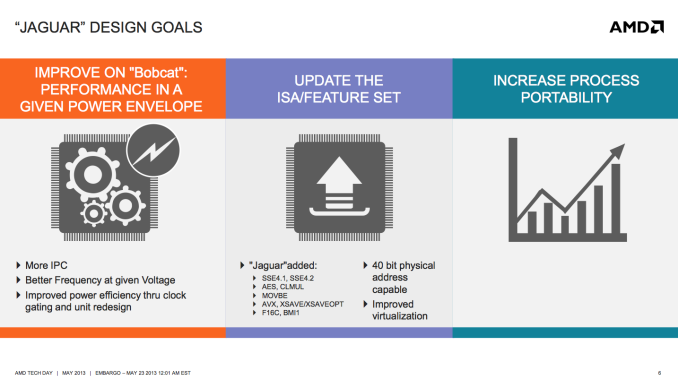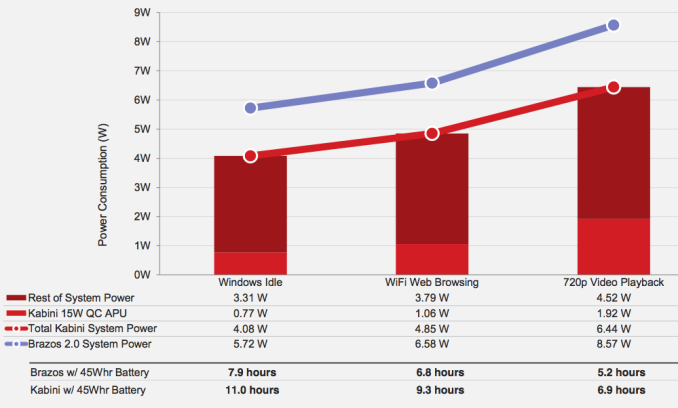AMD’s Jaguar Architecture: The CPU Powering Xbox One, PlayStation 4, Kabini & Temash
by Anand Lal Shimpi on May 23, 2013 12:00 AM ESTFinal Words
Bobcat was a turning point for AMD. The easily synthesized, low cost CPU design was found in the nearly 50 million Brazos systems AMD sold since its introduction. Jaguar improves upon Bobcat in a major way. The move to 28nm helps drive power even lower, which will finally get AMD into tablet designs with Temash. Despite being lower power, Jaguar also manages to increase performance appreciably over Bobcat. AMD claims up to a 22% increase in IPC compared to Bobcat. Combine the IPC gains with a more multi-core friendly design and Jaguar based APUs should be appreciably faster than their predecessors.
Quite possibly one of the only real weaknesses with Jaguar is the lack of aggressive turbo modes in any of the shipping implementations of the design. It appears that the first implementations of Jaguar were under time constraints, leaving many features (including improved thermal monitoring/management and turbo boost) on the cutting room floor. Kabini and Temash seem ripe for a mid-cycle update enabling turbo across more parts, which could do wonders for single threaded performance.
The Jaguar power story actually looks very good, it's just hampered by traditional PC legacy. None of the launch APUs here support the low power IOs necessary to drive platform power down even further. AMD is getting very close though. Jaguar's core power is easily sub-2W for lightweight tablet tasks, the rest of the platform (excluding display) drives it up to 4 - 7W. AMD definitely has the right building blocks to go after truly low power tablets in a major way, should it have the resources and bandwidth to do so.
In its cost and power band, Jaguar is presently without competition. Intel’s current 32nm Saltwell Atom core is outdated, and nothing from ARM is quick enough. It’s no wonder that both Microsoft and Sony elected to use Jaguar as the base for their next-generation console SoCs, there simply isn’t a better option today. As Intel transitions to its 22nm Silvermont architecture however Jaguar will finally get some competition. For the next few months though, AMD will enjoy a position it hasn’t had in years: a CPU performance advantage.
I can’t stress enough how important it is that AMD continues to focus on driving the single threaded performance of its cat-line of cores. Second chances are rare in this business, but that’s exactly what AMD has been offered with the rise of good enough computing. Jaguar vs. Atom is the best CPU story AMD has had in years. Regular updates to the architecture coupled with solid execution are necessary to ensure that history doesn’t repeat itself in a new segment of AMD’s business.
Long term, I can’t help but wonder what Bobcat’s success will do to shape AMD’s future microarchitecture decisions. I’m not sure what Jim Keller’s SoC project is, but I’m wondering if the days of really big cores might be over. I don’t know that really small cores are the answer either, but perhaps something in between...












78 Comments
View All Comments
Krysto - Friday, May 24, 2013 - link
Still don't see why OEM's would choose AMD's APU's in Android tablets over ARM, though.It's weaker CPU wise, and most likely weaker GPU wise, too. We'll see when they come out if their GPU's can stand up to Adreno 330, PowerVR Series 6 and Mali T628. Plus, it requires quite a bit of power.
In my book no chip that can't be used in a smartphone (and I'm talking about the exact same model, not the "brand") should be called a "mobile chip".
This idea about "tablet chips" is nonsense. Tablet chips is just another way of saying our chip is not efficient enough, so we're just going to compensate for that with a much larger battery, that adds more to weight, charging time, and of course price.
ReverendDC - Monday, May 27, 2013 - link
Even an Atom chip is more powerful per cycle than ARM, and AMD's stuff is more powerful than Atom. I'm not exactly sure what you are using to state that ARM is more powerful, but AnandTech did a great comparison themselves.By the way, the comparisons in some cases are for quad core ARM vs. single core Atom at comparable speeds. Again, really not sure where your "facts" come from.
BernardBlack - Wednesday, May 29, 2013 - link
ARM actually isn't all that...and it's quite the other way around.As I have seen it stated elsewhere, "Simply: x86 IPC eats ARM for lunch while actual performance and power usage will scale together. That is why ARM currently has no real business competing against x86"
BernardBlack - Wednesday, May 29, 2013 - link
It's all about instructions per cycle and that is what AMD and Intel do best.BernardBlack - Wednesday, May 29, 2013 - link
not to mention, the IPC's in these processors follow suit with their server Opteron processors, which means, they achieve even greater IPC's per cycle. This is how you are able to have 1.6ghz CPU's that can compete with many common 3-4ghz desktop processors.eanazag - Friday, May 31, 2013 - link
They could use the exact same hardware design to sell Android and Windows tablets.Wolfpup - Wednesday, June 12, 2013 - link
Huh? AMD's Bobcat parts are more powerful than ARM's stuff. ARM's only just now managing to sort of compete with first gen Atom at best, and that with a CPU that's not actually used in much.And "tablet chips" is NOT nonsense. You have more power budget, and higher expectations for performance in a tablet. If it's "nonsense", why does Apple put bigger chips in their tablets? Why can tablets run Core i CPUs? Why do they typically get bigger chips first even with Android?
Wolfpup - Wednesday, June 12, 2013 - link
To add to that, THIS article explicitly says "Jaguar is presently without competition...nothing from ARM is quick enough."So really, where the heck are you getting the idea ARM has more powerful chips?
kyuu - Thursday, May 23, 2013 - link
I think the main point of this is getting into the mobile market. Temash looks like a great chip for a tablet. The only problem is OEMs not biting because they think they have to put an Intel sticker on the box for it to sell.Personally, I'm waiting on a good tablet with Temash to finally jump into the Win8 tablet club. Whatever OEM makes a good one first will be getting my money.
mikato - Friday, May 24, 2013 - link
I think with tablets, OEMs are even less likely to think they need to put an Intel sticker on it. Joe Schmo knows Intel doesn't mean as much for tablets. The most well known tablets aren't Intel. This is an opening for AMD to be able to get in the game late if they want to.Actually, do they even put stickers on tablets?